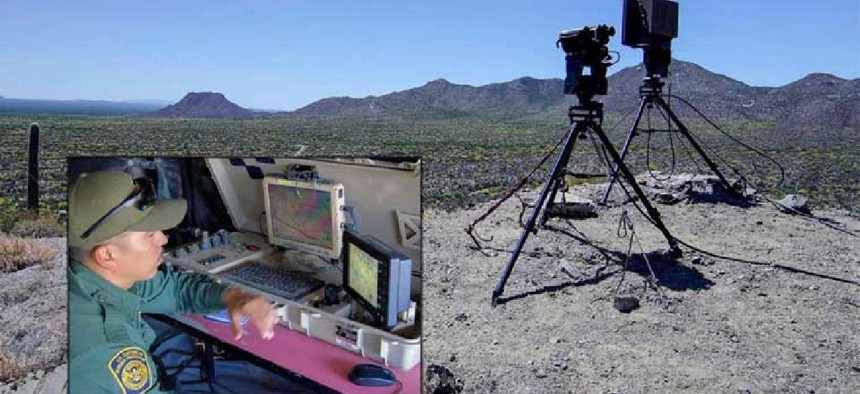Border tech in the budget


Connecting state and local government leaders
Sensors, advanced analytics, screening technologies are critical elements of layered border security, Department of Homeland Security acting secretary says.
The technological capabilities that accompany President Donald Trump’s signature border wall project -- sensors, cameras, advanced analytics, drones, non-invasive screening – are critical elements of border protection, Department of Homeland Security Acting Secretary Chad Wolf recently told a Senate budget panel.
On Feb. 25 Wolf spoke before the Appropriations Committee’s Homeland Security Subcommittee defending the DHS fiscal 2021 budget request of $2 billion for construction of 82 miles of new "border wall system."
That layered system, according to Wolf, includes portable autonomous surveillance towers that would provide "persistent electronic surveillance in remote areas of the border" without border protection officers. The data from the towers will be transmitted in real time to Customs and Border Protection's Air and Marine Operations Center and local Border Patrol stations for processing, threat determination and response execution, Wolf said.
The proposal would also provide money to upgrade border aircraft and replace non-high definition electro optic/infrared sensors, outdated mapping systems, video displays, recorders and data links.
Acting CBP Commissioner Mark Morgan told a House budget subcommittee on Feb. 27 that “data shows that the multi-layer strategy of infrastructure, technology and personnel works.”
He provided more details about the “border wall system” that includes barriers, access roadways, sensors and cameras. It has cut illegal entries and “get-aways” of people that have crossed the border illegally by as much as 80% in a 20-mile stretch of El Paso, Texas, Morgan told the committee. The same is true in Yuma, Ariz. where similar multi-layer strategy is in place, he said.
In his testimony, Morgan highlighted some of the technology requested for securing the border:
- 30 new autonomous surveillance towers, bringing the program total to 200 towers.
- Mobile and remote video surveillance systems.
- Small drones and funding for maintenance of larger drones in CBP’s fleet.
- Modernization of the Border Enforcement Coordination Network that supports the planning, detection, classification and analysis of illegal border activity.
- Advanced analytics capabilities for the National Vetting Center and the Advanced Trade Analytics Platform that supports CBP’s trade analysis and enforcement initiatives.
- Migration of the Automated Commercial Environment to a cloud-based platform.
- Non-intrusive inspection systems to inspect and screen cars, trucks, railcars and sea containers, as well as personal luggage, packages, parcels and flat mail.
Earlier in the month, the House approved a bipartisan bill that would require DHS to report to Congress how it plans to use large-scale non-intrusive inspection systems at land ports of entry.
The Securing America's Ports Act would bolster legislation passed in 2018 and 2019 that requires more electronic gear for CBP officers to detect illicit drug shipments in the mail and get advanced data transmissions from shippers describing the contents international packages coming into the U.S.
This bill is designed to address the biggest gaps in interdiction -- the influx of drugs through U.S. land ports of entry on the southern border.
Wolf told the Senate budget panel that CBP currently screens only 1% of passenger vehicles and 5% of commercial vehicles at land ports of entry for narcotics. He said he hopes that Congress will authorize funding to support CBP’s goal of using non-invasive inspection tech so it can boost screening to 40% of passenger vehicles and 72% of commercial vehicles by 2023.
The screening technology is having some effect, having uncovered a record shipment of drugs at a border port. Jim Carroll, director of the White House's Office of Drug Control Policy, announced on Feb. 22 that non-intrusive inspection gear at the southern border detected 875 lbs. of methamphetamine, worth $18 million, hidden in a shipment of broccoli.
This article is a combination of two reports from FCW, a sibling site to GCN.




